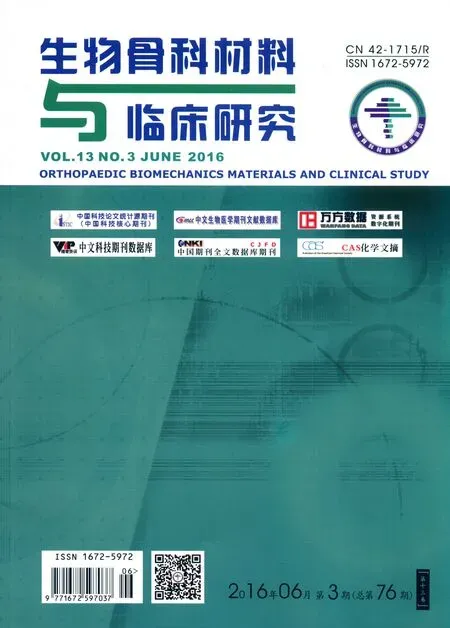距骨骨软骨损伤研究现状
王勇平朱兆金徐向阳*
距骨骨软骨损伤研究现状
王勇平1,2朱兆金1徐向阳1*
距骨骨软骨损伤是踝关节慢性疼痛的主要病因之一,根据病史、临床症状及影像学检查一般可确诊。目前,距骨骨软骨损伤的治疗方法众多,包括微骨折术、钻孔术、自体或异体软骨移植、软骨细胞移植等,但远期疗效尚不明确。本文就距骨骨软骨损伤的病因、损伤机制、分期、诊断及治疗研究现状作一综述。
距骨;骨软骨损伤;手术治疗;关节镜;软骨移植;软骨细胞移植
距骨骨软骨损伤(Osteoehondrallesionsofthetalus,OLT)是踝关节慢性疼痛的主要病因之一,多见于男性,通常发生在20~30岁之间,约10%双侧受累[1]。由于距骨表面大部分(约3/5)被软骨覆盖,血供薄弱,因此当距骨骨软骨损伤时,仅具有有限的自我修复能力。尽管距骨骨软骨损伤的治疗方法众多,包括微骨折术、钻孔术、自体或异体软骨移植、软骨细胞移植等,但远期疗效尚不明确。本文就距骨骨软骨损伤的病因、损伤机制、分期、诊断及治疗现状作一综述。
1 病因
明显的创伤或者反复的微创伤是引起距骨骨软骨损伤的主要原因。Flick等[2]分析了500例距骨骨软骨损伤患者,结果发现98%的距骨顶内侧和70%的距骨顶外侧损伤与创伤有关系。5%~9%的踝关节扭伤合并距骨骨软骨损伤;28%~73%的踝关节骨折合并距骨骨软骨损伤。没有明显外伤史的患者,激素失调、内分泌因素、遗传因素、骨化异常、应用激素、酗酒和体质异常可能起重要作用[3]。Ferkel等[4]指出一些先天性和/或获得性因素可以引起微血管血供减少,继而导致缺血,从而引起软骨损伤,最终导致软骨下骨损伤。
2 发病机制
软骨、软骨下骨板和软骨下网状骨构成一个解剖单位。如果外力作用大于软骨和软骨下骨所能承受的剪切力时,可造成软骨和软骨下骨损伤;如果外力作用小于软骨所能承受的剪切力,而大于软骨下骨所能承受的剪切力时,则仅造成软骨下骨损伤。
距骨骨软骨损伤可发生于距骨软骨面的任何部位,但典型的距骨骨软骨损伤发生距骨穹窿的后内侧和前外侧。距骨穹窿内侧缘损伤由足内翻、跖屈和胫骨外旋暴力联合造成,该力导致距骨穹窿内侧缘与内踝关节面发生撞击;距骨穹窿外侧缘损伤由足外翻、背伸和胫骨内旋暴力联合造成,该力导致距骨穹窿外侧缘与外踝关节面发生撞击。
3 诊断
3.1 临床表现
距骨骨软骨损伤的典型临床表现是以前存在踝关节扭伤病史后,出现踝关节慢性持续性疼痛,或者反复踝关节肿胀、乏力、僵硬或不稳。
体格检查时,踝关节不同部位压痛点提示不同部位损伤,当踝关节跖屈时距骨顶前外侧压痛,提示距骨前外侧骨软骨损伤;当踝关节背伸时距骨顶后内侧压痛,提示距骨后内侧骨软骨损伤。踝关节稳定性检查包括前抽屉试验、内外翻应力试验。测量踝关节活动度,并与健侧对比。体格检查应排除神经性与血管性疼痛。急性期患者需排除踝关节骨折和踝部韧带损伤。
3.2 影像学检查
X线片:X线片是诊断距骨骨软骨损伤的主要手段之一,负重位踝关节正、侧位及踝穴位 X线片可发现可疑损伤,但不能对软骨损伤和软骨分离移位进行判断[5]。CT:CT检查可对软骨下骨的损伤进行评价,但不能显示软骨病变。MRI:MRI是目前诊断距骨骨软骨损伤的最佳无创手段,可对软骨或软骨下骨损伤进行评估并对其进行分级,同时可发现周围软组织的损伤或异常[6]。核素骨显像:核素骨显像可发现影像学表现正常的隐性损伤,其灵敏性和特异性均较高[7]。
一般来讲,对伴肿胀或明显压痛的急性踝部损伤,应常规摄踝关节正、侧、斜位及踝穴位X线片以明确诊断;若发现骨软骨损伤应行CT检查,以明确损伤大小、形状、部位及移位;对踝部持续疼痛而X线片无阳性表现者,应进行MRI检查或核素骨显像检查。
3.3 关节镜检查
关节镜具有一定的创伤性,对于软骨自身病变的诊断具有很高的灵敏性和特异性,但对软骨下骨的病变显示能力有限[8]。
4 分型及分期
4.1 分型
根据发病时间来分,距骨软骨损伤可分为急性和慢性损伤。根据发病机制来分,距骨软骨损伤可分为创伤性和退变性损伤。根据损伤部位来分,距骨骨软骨损伤可分为前外侧穹窿和后内侧穹窿损伤。根据损伤程度来分,距骨骨软骨损伤可分为距骨软骨损伤、距骨软骨下骨损伤和距骨骨缺损。
4.2 分期
根据 X线片表现,距骨骨软骨损伤可分为五期:Ⅰ期为软骨下骨压缩;Ⅱ期为软骨与骨床部分分离;Ⅲ期为软骨与骨床完全分离,但无移位;Ⅳ期为软骨与骨床完全分离,且有移位;Ⅴ期为软骨下囊肿[5]。
根据MRI表现,距骨骨软骨损伤可分为五期:Ⅰ期为软骨损伤;Ⅱa期为软骨损伤伴有软骨下骨损伤和周围骨髓水肿;Ⅱb期为软骨损伤伴有软骨下骨损伤,但无周围骨髓水肿;Ⅲ期为软骨与骨床分离,但无移位;Ⅳ期为软骨与骨床分离,且有移位;Ⅴ期为软骨下囊肿[9]。
根据关节镜表现,距骨骨软骨损伤可分为六期:A期:软骨平滑完整,但比较柔软;B期:软骨表面粗糙;C期:软骨纤维化或裂缝形成;D期:出现软骨片或骨质外露;E期:软骨片分离,但无移位;F期:软骨层分离,且有移位[10]。
同时适用于MRI和关节镜的分期:0期,正常;1期,软骨面保持完整,但在T2WI上呈高信号;2期,软骨面原纤维形成或有裂隙,但未累及软骨下骨;3期,软骨片悬垂或软骨下骨暴露;4期,有松弛、无移位的骨碎片;5期,有移位的骨碎片[11]。
5 治疗选择
目前,对于距骨骨软骨损伤的治疗策略存在着争议。从非手术治疗到手术治疗,许多学者根据损伤的分期来治疗,另一些学者则主张根据损伤的范围来治疗。
5.1 非手术治疗
非手术治疗包括休息,避免剧烈活动以及药物治疗。Ⅰ期损伤,采取保守治疗是没有争议的。对于Ⅱ期损伤,一些学者主张在决定手术前应采取至少1年的非手术治疗[12]。
非手术治疗初期采用非负重石膏制动,后期采用保护性制动并逐渐活动。药物治疗采用前列环素类,如伊洛前列素(Iloprost)治疗无软骨下骨损伤的患者,可改善局部血运,减轻骨髓水肿。Aigner等[13]应用伊洛前列素治疗骨髓水肿,经过3个月治愈,疗效较好。
5.2 手术治疗
非手术治疗无效、Ⅲ-Ⅳ期及软骨损伤直径>1.5cm者,可考虑手术治疗。距骨骨软骨损伤的手术治疗包括病灶清除、刺激软骨生长(包括微骨折术,或钻孔术);如果软骨片足够大,可以进行保护距骨顶的钻孔、植骨以及内固定术;其他方法包括自体或异体软骨移植及自体软骨细胞移植。
5.2.1 病灶清除、钻孔或微骨折术
病灶清除、钻孔或微骨折术用于治疗完全分离,但没有移位或无需内固定的骨软骨损伤。可以在关节镜下进行,也可以开放进行。手术时完全切除病变,清除损伤表面的碎屑和失活组织。手术时穿透软骨下骨组织可使骨内的血管破裂,释放出生长因子形成纤维蛋白凝块,刺激局部产生新生血管,诱导新生细胞进入软骨缺损处,最终完成纤维软骨修复。
关节镜技术是距骨骨软骨损伤的主要手术方法,对软骨完全分离而无法采用内固定术的患者尤为适用[8]。单纯病灶清除疗效不佳,结合钻孔术可获得更好的疗效[14]。术中清除全部病灶及失活组织,清理损伤表面,随后钻孔以建立流经软骨下骨组织的血运,使骨髓组织能迁移至缺血部位,刺激缺损区域纤维软骨形成。为了产生血管再生,钻孔可以从内踝或者外踝或者逆行经距骨进行。Kono等[15]采用关节镜辅助逆行钻孔技术,取得较好疗效。逆行钻孔术联合植骨是治疗Ⅴ期损伤的理想方法,钻孔可提供再血管化,而植骨可提供骨诱导与骨传导[16]。
Becher等[17]采用微骨折术治疗34例距骨骨软骨损伤,疗效较好。Kuni等[18]和Chuckpaiwong等[19]采用微骨折术治疗距骨骨软骨损伤,获得良好功能,且不受年龄限制。Guney等[20]采用微骨折术结合富含血小板血浆(PRP)技术治疗距骨骨软骨损伤,结果显示疗效优于单纯的微骨折术。
5.2.2 自体或异体软骨移植术
目前倾向于采用自体软骨移植或自体骨软骨柱镶嵌移植术来治疗较大的软骨缺损。以自体非负重关节面为供区,一般取同侧膝关节非负重区域(如股骨髁内外侧部)或同侧距骨关节突的内外侧部位的软骨[21]。Marymont等[22]采用股骨髁外上方软骨移植治疗距骨骨软骨损伤,获得良好的效果。Scranton等[23]采用自体软骨移植术治疗50例Ⅴ期距骨骨软骨损伤,优良率达90%。Hangody等[24]采用自体软骨移植治疗>1cm的距骨骨软骨损伤,随访2~7年,优良率为94%。自体骨软骨柱镶嵌移植术可用于治疗直径>10 mm的距骨骨软骨损伤。Kreuz等[25]采用自体距骨软骨柱镶嵌移植术治疗35例距骨骨软骨损伤,随访4年,AOFAS评分平均提高30.1~39分,症状及功能均得到明显改善。Nakagawa等[26]报告1例距骨骨软骨损伤患者,采用自体骨软骨柱镶嵌移植术治疗,术后2年复发,认为超量使用可能是引起复发的主要原因,建议自体骨软骨柱镶嵌移植术应仔细操作,确保病变周围无硬化骨,以避免复发。自体软骨移植术治疗损伤面积有限;移植后损伤区域留有死腔,发生纤维软骨填充;由于移植软骨的厚度不同,发生移植区的关节面不平整。
对缺损较大、难以接受自体软骨移植术的患者,可采用异体软骨移植术。Raikin[27]对6例面积>3cm2的距骨软骨缺损采用同种异体软骨移植进行治疗,平均随访23个月,术后AOFAS评分平均改善44分,所有患者均对手术表示满意。Anderson等[28]采用异体骨移植术治疗距骨骨软骨损伤,11位患者12例踝关节,平均随访38个月,术后90%患者满意。Haene等[29]采用异体骨移植术治疗距骨骨软骨损伤,16例患者17例踝关节,平均随访4.1年,结果2例进行了翻修,5例手术失败。尽管异体软骨移植术可用于修复软骨面并可避免供区损伤,但术后恢复时间长、排异反应、软骨存活力有限。
进行软骨移植术时,需充分暴露距骨穹窿,内踝截骨有利于暴露距骨穹窿内侧部,腓骨截骨可最大程度暴露距骨穹窿外侧部[30]。Lee等[31]采用改良内踝阶梯状截骨,可充分暴露距骨穹窿部。Kreuz等[32]采用前方入路胫骨楔形截骨暴露后方距骨穹窿部。必要时术中用撑开器或外固定支架撑开踝关节以暴露距骨穹窿部[33]。Garras等[34]主张采用逆行软骨移植术,既可避免截骨,也可取得较好疗效。
5.2.3 自体软骨细胞移植术
自体软骨细胞移植术是治疗距骨骨软骨损伤较新的手术方法,这种技术分为两个阶段,先在体外进行软骨细胞的培养、收集和扩增,再将细胞移植到软骨损伤部位。Giannini等[35]采用自体软骨细胞移植术治疗距骨骨软骨损伤,对损伤深度>5 mm的患者先行自体松质骨植骨后再行自体软骨细胞移植,术后随访36个月,患者症状得到显著缓解,功能恢复良好,AOFAS评分从平均57.2提高到平均89.5。Koulalis等[36]采用自体软骨细胞移植术治疗距骨骨软骨损伤,术后效果良好。Whittaker等[37]采用自体软骨细胞移植术治疗9例距骨骨软骨损伤,术后1年,移植处软骨生长良好并覆盖缺损区域。Baums等[38]采用自体软骨细胞移植术治疗距骨骨软骨损伤,术后移植处软骨生长较好,AOFAS评分平均从43.5提高至88.4。与自体软骨移植术相比,自体软骨细胞移植术早期疗效较好,术后缺损覆盖完全,透明软骨生长好,其优势在于不受软骨缺损面积限制,也无供区损伤。5.2.4内固定术
距骨骨软骨损伤内固定术适用于软骨碎片较大并附有大量软骨下骨的患者。距骨骨软骨损伤的内固定方法很多,如克氏针、皮质骨螺钉、可吸收螺钉,都可取得较好的效果。Schuh等[16]采用克氏针治疗的不稳定性距骨骨软骨损伤,随访4年以上,治疗效果佳。Kumai等采用皮质骨螺钉内固定治疗慢性不稳定性距骨骨软骨损伤,随访7年,影像学评价较好。Zetent等[39]采用可吸收螺钉内固定治疗距骨骨软骨损伤,术后9个月随访,结果显示患者功能恢复满意。
进行内固定手术时,可根据病变部选择手术入路,距骨穹隆外侧病变可行前外侧或后外侧入路,前内侧病变可行前内侧入路,后中部病变可切除内踝以获得充分暴露。
6 结语
距骨骨软骨损伤是踝关节慢性疼痛的主要病因之一,距骨骨软骨损伤的病因尚不明确,创伤或者反复的微创伤可能是主要原因。根据病史、临床症状及影像学检查一般可确诊。早期稳定性距骨骨软骨损伤(Ⅰ期、Ⅱ期)可采用保守治疗,损伤较严重者(Ⅲ-Ⅴ期)采用手术治疗。关节镜技术是距骨骨软骨损伤的主要治疗方法,创伤小,效果好;缺损较大的距骨骨软骨损伤,内固定术和自体软骨移植术的治疗效果较好;自体软骨细胞移植术可能成为今后治疗的趋势。
[1]Elias I,Jung JW,Raikin SM,et a1.Osteochondral lesions of the talus:change in MRI findings over time in talar lesions without operative intervention and implications for staging systems[J].Foot Ankle Int,2006,27(3):157-166.
[2]Flick AB,Gould N.Osteochondritis dissecans of the talus(transchondral fractures of the talus):review of the literature and new surgical approach for medial dome lesions[J].Foot Ankle,1985, 5(4):165-185.
[3]Santrock RD,Buchanan MM,Lee TH,et a1.Osteochondral lesions of the talus[J].Foot Ankle Clin,2003,8(1):73-90.
[4]Ferkel RD,Flannigan BD,Elkins BS.Magnetic resonance imaging of the foot and ankle:correlation of normal anatomy with pathologic conditions[J].Foot Ankle,1991,11(5):289-305.
[5]Berndt AL,Harty M.Transchondral fractures(osteochondritis dissecans)of the talus[J].J Bone Joint Surg(Am),1959,41(6): 988-1020.
[6]Verhagen RA,Maas M,Dijkgraaf MG,et al.Prospective study on diagnostic strategies in osteochondral lesions of the talus.Is MRI superior to helical CT[J].J Bone Joint Surg(Br),2005,87(1):41-46. [7]Urman M,Ammann W,Sisler J,et a1.The role of bone scintigraphy intheevaluation of talar domefractures[J].JNuclMed,1991, 32:2241-2244.
[8]Ferkel RD,Zanotti RM,KomendaGA,etal.Arthrascopic treatment of chronic osteochondral lesiom of the talus:long-term results[J]. Am J Sports Med,2008,36(9):1750-1762.
[9]Hepple S,Winson IG,Glew D.Osteochondral lesions of the talus: a revised classification[J].Foot Ankle Int,1999,20(12):789-793.
[10]Cheng MS,Ferkel RD,Applegate GR.Osteochondral lesions of the talus:a radiologic and surgical comparison[J].New Orleans, 1995:16-21.
[11]Mintz DN,Tashjian GS,Connell DA,et a1.Osteochondral lesions ofthetalus:a new magneticresonance grading systemwitharthroseopic correlation[J].Arthroscopy,2003,19(4):353-359.
[12]Tol JL,Struijs PA,Bossuyt PM,et al.Treatment strategies in osteochondral defects of the talar dome:a systematic review[J].Foot Ankle Int,2000,21(2):119-126.
[13]Aigner N,Petje G,Steinboeck G,et al.Treatment of bone-marrow oedema of the talus with the prostacyclin analogue iloprost.An MRI-controlled investigation of a new method[J].J Bone Joint Surg(Br),2001,83(6):855-858.
[14]Ferkel RD,Scranton PE Jr,Stone JW,et al.Surgical treatment of osteochondral lesions of the talus[J].Instr Course Lect,2013,59: 387-404.
[15]Kono M,Takao M,Naito K,et al.Retrograde drilling for osteochondral lesions of the talar dome[J].Am J Sports Med,2006, 34(9):1450-1456.
[16]Schuh A,Salminen S,Zeiler G,et al.Results of fixation of osteochondral lesions of the talus using K-wires[J].Zentralbl Chir, 2004,129(6):470-475.
[17]Becher C,Driessen A,Hess T,et al.Microfracture for chondral defects of the talus:maintenance of early results at midterm followup[J].Knee Surg Sports Traumatol Arthrosc,2010,18(5):656-663.
[18]Kuni B,Schmitt H,Chloridis D,et al.Clinical and MRI results after microfracture of osteochondral lesions of the talus[J].Arch Orthop Trauma Surg,2012,132(12):1765-1771.
[19]Chuckpaiwong B,Berkson EM,Theodore GH.Microfracture for osteochondral lesions of the ankle:outcome analysis and outcome predictors of 105 cases[J].Arthroscopy,2008,24(1):106-112.
[20]Guney A,Akar M,Karaman I,et al.Clinical outcomes of platelet rich plasma(PRP)as an adjunct to microfracture surgery in osteochondral lesions of the talus[J].Knee Surg Sports Traumatol Arthrosc,2013[Epub ahead of print].
[21]Gross AE,Agnidis Z,Hutchison CR.Osteochondral defects of the talus treated with fresh osteochondral allograft transplantation[J]. Foot Ankle Int,2001,22(5):385-391.
[22]Marymont JV,Shute G,Zhu H,et al.Computerized matching of autologous femoral grafts for the treatment of medial talar osteochondral defects[J].Foot Ankle Int,2006,26(9):708-712.
[23]ScrantonPE Jr,McDermott JE.Treatment of type V osteochondral lesions of the talus with ipsilateral knee osteochondral autografts [J].Foot Ankle Int,2001,22(5):380-384.
[24]Hangody L,Kish G,Modis L,et al.Mosaicplasty for the treatment of osteochondritis dissecans of the talus:two to seven year results in 36 patients[J].Foot Ankle Int,2001,22(7):552-558.
[25]Kreuz PC,Steinwachs M,Erggelet C,etal.Mosaicplasty with autogenous talar autograft for osteochondral lesions of the talus after failedprimaryathroscoppic management:aprospectivestudy with a 4-year follow-up[J].AM J Sports Med,2006,34(1):55-63.
[26]Nakagawa Y,Suzuki T,Matsusue Y,et a1.Bony lesion recurrence after mosaicplasty for osteochondritis dissecans of the talus[J]. Arthroscopy,2005,21:630.
[27]Raikin SM,Stage VI.Massive osteochondral defects of the talus [J].Foot Ankle Clin,2004,9:737-744.
[28]Anderson DD,Tochigi Y,Rudert MJ,et al.Fresh osteochondral allografting for osteochondral lesions of the talus[J].Foot Ankle Int, 2010,31(4):283-290.
[29]Haene R,Qamirani E,Story RA,et al.Intermediate outcomes of fresh talar osteochondral allografts for treatment of large osteochondral lesions of the talus[J].J Bone Joint Surg(Am),2012,94(12): 1105-1110.
[30]Kilicoglu O,Taser O.Retrograde osteochondral grafting for osteochondral lesions of the talus:a new technique eliminating malleolar osteotomy[J].Acta Orthop Ttaumatol Turc,2005,39(3): 274-279.
[31]Lee KB,Bai LB,Chung JY,et al.Arthroscopic microfracture for osteochondral lesions of the talus[J].Knee Surg Sports Traumatol Arthrosc,2010,18(2):247-253.
[32]Kreuz PC,Lahm A,Haag M,et al.Tibia wedge osteotomy for osteochondral transplantation in talar lesions[J].Int J Sports Med, 2008,29(7):584-589.
[33]Dela-Cruz EL,Brockbank GR.Use of the noninvasive ankle distractor with talar dome osteochondal graft transplantation[J].J Foot Ankle Surg,2005,44(4):311-312.
[34]GarrasDN,Satangclo JA,Wang DW,et a1.A quantitative comparisonof surgicalapproaches for posterolateral osteochondral lesions of the talus[J].Foot Ankle Int,2008,29(4):415-420.
[35]Giannini S,Buda R,Vannini F.Arthroscopic autologous chondrocyte implantation in osteochondral lesions of the talus:surgical technique and results[J].AM J Sports Med,2008,36:873-880.
[36]Koulalis D,Schultz W,Heyden M.Autologous chondrocyte transplantation for osteochondritis dissecans of the talus[J].Clin Orthop Relat Res,2002(395):186-192.
[37]Whittaker JP,Smith G,Makwana N,et a1.Early results of autologous chondrocyteimplantationin the talus[J].J Bone Joint Surg Br, 2005,87:179-183.
[38]Baums MH,Heidrich G,Schultz W,et a1.Autologous chondroeyte transplantation for treating cartilage defects of the talus[J].J Bone Joint Surg Am,2006,88:303-308.
[39]Zelent ME,Neese DJ.Talar dome fracture repaired using bioabsorbable fixation[J].J Am Pediatr Med Assoc,2006,96(3): 256-259.
Research status of osteochondral lesions of the talus
Wang Yongping1,2,Zhu Zhaojin1,Xu Xiangyang1.
1Department of Orthopedics,Rui Jin Hospital of Shanghai JiaoTong University,Shanghai,200233;2 Department of Orthopedics,the First Hospital of Lanzhou University,Lanzhou Gansu 730000,China
Osteochondral lesions of the talus is one ofthemajorcauses of chronic pain in ankle.Accordingto the medical history,clinical symptomsandimaging examination,the diagnosisof osteochondrallesionsof the taluscanbeconfirmed. At present,the treatment of osteochondral lesions of the talus contenst micro-fracture,drilling,autologous or allogeneic osteochondral transplantation and chondrocyte transplantation,but the long-term effect is not clear.In this paper,we reviewresearchstatusof osteochondrallesionsofthetalus,includingthe etiology,pathogenesis,classification,diagnosis and treatment.
Talus;Osteochondrallesions;Operativetreatment;Arthroscopy;Osteochondraltransplantation;Chondrocyte transplantation
R683
B
10.3969/j.issn.1672-5972.2016.03.018
swgk2015-10-00206
王勇平(1975-)男,博士、博士后,副主任医师,研究方向:关节外科及骨科生物材料。
*[通讯作者]徐向阳(1962-)男,博士,教授,主任医师,博士生导师。研究方向:足踝外科学。
2015-10-15)
1上海交通大学附属瑞金医院骨科,上海200223;2兰州大学第一医院骨科,甘肃兰州730000

